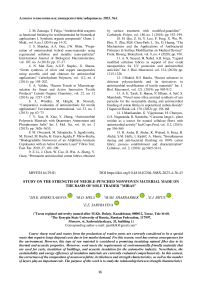Study on the strength of needle-punched nonwoven material made on the basis of sole trader "Miras"
Автор: Borkulakova Zh.K., Mels M.D., Shardarbek M.Sh., Bitus E.I., Sarybayeva E.E.
Журнал: Вестник Алматинского технологического университета @vestnik-atu
Рубрика: Технология текстиля и одежды, дизайн
Статья в выпуске: 4 (142), 2023 года.
Бесплатный доступ
Coarse sheep wool and wastes from the production of woolen yarns are currently considered to be a special waste that requires large disposal costs due to low market demand. For this reason, wool has serious consequences for the environment. However, this type of raw material is considered a promising insulating natural fiber due to its thermal and acoustic properties. Moreover, wool meets the requirements of environmentally friendly materials that are used for yurts, insulation of buildings, and acoustic insulation for the automotive industry. Nevertheless, the sustainability and energy efficiency of insulation materials are currently evaluated comprehensively. In this context, the correctness of the composition of nonwoven fabric, its thickness and strength characteristics, as well as the number of layers play an important role. The purpose of this work is to study the relationship between strength characteristics and thickness, as well as the number of layers in nonwovens made of 100 % wool mixed with coarse and fine fibers, and to determine the most optimal variant of insulating nonwovens. 4 samples of one, two, three and four-layered materials were used in the study. The tested samples of insulating materials were evaluated according to the parameters of breaking load, strength and elongation. The results of the research showed that with an increase in the number of layers of material, there is an increase in the tested two indicators: breaking load and strength. The elongation rates were uneven. Consequently, by examining all three parameters, it was found that the best option is a three-layered nonwoven material.
Sheep wool, waste reuse, strength, breaking load, nonwoven fabric, natural fiber, insulation material
Короткий адрес: https://sciup.org/140303468
IDR: 140303468 | DOI: 10.48184/2304-568X-2023-4-36-43
Список литературы Study on the strength of needle-punched nonwoven material made on the basis of sole trader "Miras"
- Arshad, Khubaib, Mikael Skrifvars, Vera Vivod, Julija Volmajer Valh, and Bojana Voncina. “Biodegradation of Natural Textile Materials in Soil.” Tekstilec 57, no. 2 (June 16, 2014): 118–32. https://doi.org/10.14502/tekstilec2014.57.118-132.
- Nguyen, Quynh. “How Sustainable Are Sheep Wool Fabrics? A Life-Cycle Analysis.” Impactful Ninja, n.d. https://impactful.ninja/how-sustainable-are- sheep-wool-fabrics/.
- Balador, Zahra, Morten Gjerde, and Nigel Isaacs. “Influential Factors on Using Reclaimed and Recycled Building Materials.” In Smart Innovation, Systems and Technologies. Springer Nature, 2020. https://doi.org/10.1007/978-981-32-9868-2_4.
- Company, Woolmark. “Closing the Loop.” Awi-Woolmark 2017-Ui, September 1, 2020. https://www.woolmark.com/interiors/closing-the- loop/?_gl=1*13x6uol*_ga*MTk3MDIxMDQ0My4xNj gyMTgwMjk4*_ga_PVQKRCXXT2*MTY4MjE4ND E2Ny4yLjAuMTY4MjE4NDE2Ny4wLjAuMA.
- Ghermezgoli, Zahra Mohammadi, Meysam Moezzi, Javad Yekrang, Seyed Abbas Rafat, Parham Soltani, and Fred Barez. “Sound Absorption and Thermal Insulation Characteristics of Fabrics Made of Pure and Crossbred Sheep Waste Wool.” Journal of Building Engineering 35 (March 1, 2021): 102060. https://doi.org/10.1016/j.jobe.2020.102060.
- Zach, Jiří, Azra Korjenic, Vít Petranek, Jitka Hroudová, and Thomas Bednar. “Performance Evalua- tion and Research of Alternative Thermal Insula-tions Based on Sheep Wool.” Energy and Buildings 49 (June 1, 2012): 246–53. https://doi.org/10.1016/j.enbuild.2012.02.014.
- Tinius Olsen Testing Machine Company. “Tinius Olsen: Materials Testing Machines for Tensile, Compression, Impact and Hardness Testing.” Tinius Olsen, March 7, 2023. https://www.tiniusolsen.com/.
- Ardente, Fulvio, Marco Beccali, Maurizio Cellura, and Marina Mistretta. “Building Energy Performance: A LCA Case Study of Kenaf-Fibres Insulation Board.” Energy and Buildings 40, no. 1 (January 1, 2008): 1–10. https://doi.org/10.1016/j.enbuild.2006.12.009.
- Papadopoulos, A. “State of the Art in Thermal Insulation Materials and Aims for Future Developments.” Energy and Buildings 37, no. 1 (January 1, 2005): 77–86. https://doi.org/10.1016/j.enbuild.2004.05.006.
- Pennacchio, Roberto, Lorenzo Savio, Daniela Bosia, Francesca Thiebat, Gabriele Piccablotto, Alessia Patrucco, and Stefano Fantucci. “Fitness: Sheep-Wool and Hemp Sustainable Insulation Panels.” Energy Procedia 111 (March 1, 2017): 287–97. https://doi.org/10.1016/j.egypro.2017.03.030.
- Ye, Zhenyu, Carol L. Wells, C. G. Carrington, and Neil Hewitt. “Thermal Conductivity of Wool and Wool-Hemp Insulation.” International Journal of Energy Research 30, no. 1 (January 1, 2006): 37–49. https://doi.org/10.1002/er.1123.
- Cheung, Hoi Yan, Mei-Po Ho, Kin-Tak Lau, Francisco Cardona, and David S.C. Hui. “Natural Fibre- Reinforced Composites for Bioengineering and Environmental Engineering Applications.” Composites Part B-Engineering 40, no. 7 (October 1, 2009): 655–63. https://doi.org/10.1016/j.compositesb.2009.04.014.
- Petit-Breuilh, Ximena, Christopher J. Whitman, Claudia Lagos, Gabriela Armijo and Nicolás Schiappacasse. “Natural Fibre Insulation in Rural Southern Chile.” (2013).
- Schiavoni, S., F. D׳Alessandro, F. Bianchi, and Francesco Asdrubali. “Insulation Materials for the Building Sector: A Review and Comparative Analysis.” Renewable & Sustainable Energy Reviews 62 (September 1, 2016): 988–1011. https://doi.org/10.1016/j.rser.2016.05.045.
- Qian, Xiao Ming, and Hua Wu Liu. Advanced Textile Materials. Trans Tech Publications Ltd, 2011.


